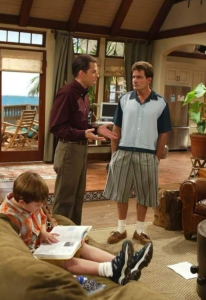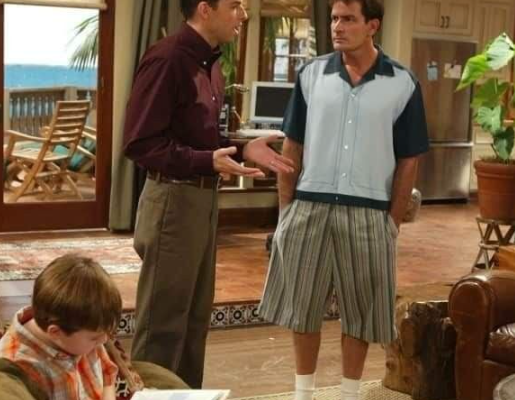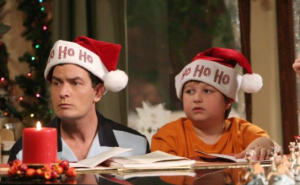
Two and a Half Men: A Sitcom That Defined a Generation of Comedy
When Two and a Half Men premiered in 2003, few expected it to become one of the longest-running and most successful sitcoms of its era. Set against the backdrop of sunny Malibu, California, the series offered audiences a blend of sharp wit, outrageous humor, and heartfelt family moments. The image above perfectly captures the essence of the show: three characters whose differences made their chemistry on-screen unforgettable—Charlie Harper (Charlie Sheen), Alan Harper (Jon Cryer), and Jake Harper (Angus T. Jones).
The Premise: A Dysfunctional Yet Endearing Trio
At its core, Two and a Half Men tells the story of two brothers who couldn’t be more different. Charlie Harper is a wealthy, carefree jingle writer with a luxurious Malibu beach house and a revolving door of romantic escapades. His younger brother, Alan Harper, is the polar opposite—penny-pinching, neurotic, and perpetually unlucky in both love and finances. After Alan’s divorce, he and his young son Jake move into Charlie’s home, setting up the clash of personalities that fuels the comedy.
The brilliance of the show lies in the contrast: Charlie’s laid-back, womanizing ways constantly collide with Alan’s uptight, responsible outlook on life. Meanwhile, Jake, the “half man,” provides a steady stream of childlike innocence, comic relief, and surprising wisdom (often disguised as cluelessness).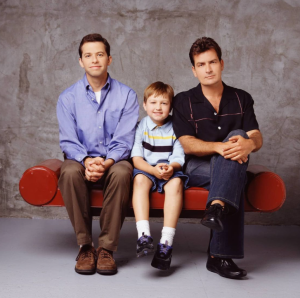
Charlie Harper: The Antihero of Sitcoms
Charlie Sheen’s portrayal of Charlie Harper quickly became one of the most iconic sitcom performances of the early 2000s. With his bowling shirts, endless sarcasm, and unapologetic bachelor lifestyle, Charlie represented the epitome of “cool uncle energy.” His beach house wasn’t just a set—it became a symbol of freedom, indulgence, and rebellion against societal expectations.
Yet, beneath the charm and swagger, Charlie Harper was a deeply flawed character. His inability to commit, his love of alcohol, and his self-centeredness often led to chaos. What made him compelling, however, was that despite all his flaws, audiences couldn’t help but root for him. Sheen infused the role with a mix of arrogance and vulnerability, creating a character who was both infuriating and lovable.
Alan Harper: The Overlooked Underdog
If Charlie Harper was the cool, reckless older brother, Alan Harper was his neurotic, unlucky counterpart. Jon Cryer’s Alan is the definition of a “nice guy who can’t catch a break.” From constant divorces to financial struggles, Alan’s misfortunes provided endless comedic fodder.
In the scene from the image, Alan is likely nagging Charlie about responsibility, money, or family matters—an ongoing theme throughout the series. While Charlie shrugged off life’s problems, Alan magnified every small issue into a crisis.
Audiences often pitied Alan, but his persistence and resilience were admirable. Despite years of ridicule from Charlie and the world around him, Alan never stopped trying to make things work. Cryer’s deadpan delivery and impeccable timing made Alan Harper one of television’s most underrated comedic characters.
Jake Harper: Growing Up on Screen
Angus T. Jones’ Jake Harper brought innocence, humor, and relatability to the series. In its early seasons, Jake was the quintessential TV kid—cute, funny, and prone to saying things that embarrassed his dad and uncle. His love of video games, food, and simple pleasures contrasted with the adult world’s complexities.
As the series progressed, Jake grew from a naïve child into a sarcastic teenager. His interactions with Charlie and Alan often highlighted the generational divide, but they also showcased the heart of the show: family. Even when Charlie and Alan fought endlessly, both remained committed to Jake’s well-being in their own unique ways.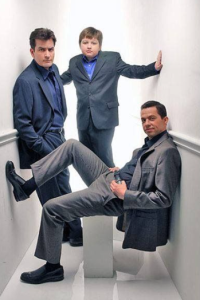
The Malibu Beach House: A Character in Itself
The setting of Two and a Half Men—Charlie’s beachfront home—was more than just a backdrop. It symbolized the clash of worlds: the luxury and carefreeness of Charlie’s life colliding with Alan’s practical, middle-class struggles.
The open living room, the sliding glass doors to the patio, and the ocean views created an inviting yet ironic environment. It was a home built for bachelorhood but transformed into a chaotic family hub once Alan and Jake moved in. Many of the show’s funniest and most heartfelt moments occurred in that living room, whether it was Jake doing homework, Charlie trying to sneak in a date, or Alan delivering one of his endless rants.
Cultural Impact and Longevity
Two and a Half Men became more than just a sitcom—it was a cultural phenomenon. For nearly a decade, it dominated ratings and became a staple of American television. Its sharp writing, memorable catchphrases, and chemistry between the lead actors made it a show that resonated across generations.
One reason for its success was its willingness to push boundaries. The humor was often risqué, filled with double entendres, and unapologetically adult. Yet, at the heart of the crude jokes was a story about family—broken, dysfunctional, but undeniably loyal.
Controversy and Change
Of course, the show was not without turbulence. Charlie Sheen’s highly publicized personal struggles eventually led to his departure in 2011. The series continued with Ashton Kutcher joining the cast as billionaire Walden Schmidt, but many fans argue that the original dynamic between Charlie, Alan, and Jake was irreplaceable.
Still, the fact that the show continued for 12 seasons is a testament to its staying power. Even after Sheen’s exit, it remained a ratings juggernaut, showing how deeply it had embedded itself in popular culture.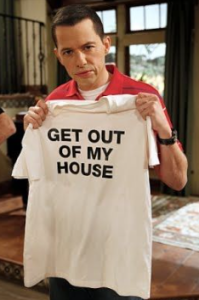
A Legacy of Laughter
Looking back, Two and a Half Men is remembered for its wit, charm, and ability to balance outrageous humor with moments of sincerity. Charlie Harper may have been a scoundrel, Alan Harper a neurotic mess, and Jake Harper a clueless kid, but together they created a family unit that audiences couldn’t help but love.
The image of Alan lecturing Charlie while Jake sits distractedly on the couch captures the heart of the series: chaos, comedy, and an underlying current of love. No matter how dysfunctional, the Harper family remained together, reminding viewers that family doesn’t always look perfect—but it’s what you make of it.
Conclusion
Two and a Half Men will always hold a special place in television history. It gave audiences characters who felt real in their flaws, stories that made us laugh while occasionally tugging at our hearts, and moments that continue to be quoted and rewatched years after the series ended.
From Charlie’s one-liners to Alan’s rants to Jake’s hilariously clueless remarks, the show delivered a comedy trifecta that kept viewers hooked for over a decade. While sitcoms come and go, the Malibu beach house and its unforgettable residents remain etched in pop culture as a reminder of a time when laughter truly was the best medicine.